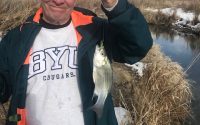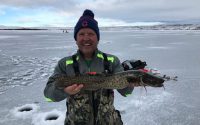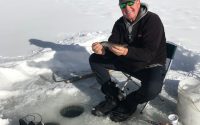How I Practice For Bass Tournaments
A surprising number of people I meet wonder how bass anglers practice for upcoming tournaments. I tell them that there is no one way to practice for tournaments. Each angler finds his/her own “best practices” and tries to stick with a game plan for the tournament based on the the results of a few days on the water before an event.
In early 2017, I spend a couple of days in the northern most parts of Lake Powell in preparation for the Spring B.A.S.S. Utah Bass Nation Spring Qualifier to earn the right to represent Utah in a Regional tournament to be held in May of this year on Clear Lake, the renowned California Reservoir and I personally believe to be the finest bass fishery in the world.
I have posted a video on YouTube highlighting one day in my several day practice period. In it, I talk about how to use large jerkbaits, drop shots, and jigs to try and establish a pattern that would produce consistent catches, anticipating movements of the fish during the two weeks between practice and the tournament.
Jerkbaits come in many sizes and for me, a large jerkbait is especially effective in the late winter or early spring. Lucky Craft makes the Pointer 128 Suspending jerkbait which is my go-to lure on many lakes, including Lake Powell. The action of a jerkbait is very erratic and in very cold water (under 55 degrees) the profile along with the action will wake up resting and lethargic bass.
On that day, and in the video, I fished an area along the main channel replete with coves, points, and outcroppings on one side of the channel, and a huge boulder field on the other. I decided that due to a fairly low water temperature (48 dgrees) that it would be best to fish points and not the backs of coves. The entire area is suited to holding bass and finding them is usually fairly easy to determine.
The keys are to experiment with reaction baits, and jigs, and fish them in the main channel, the points nearby, and finally, the backs of coves. Then, where the fish bite — the fish are. I know that sounds simplistic, but the reality is that fish need to eat and will do so, and in doing so will show you where they are.
I moved from the north to the south and compared the bites in all areas. Then, I made my decision as to where I would fish in the tournament based on three things: numbers of bites, ease of getting to the fish (distance to travel each day) and the size of fish caught.
It is crucial to keep a fishing journal to eliminate confusion when it comes to decisions like the ones above.
The last thing I try to do is get a feeling for the weather, the stage of the bite, and whether or not the fish want to bite in the morning or in the afternoon. With all these things considered I pronounce myself “ready” for the first day of the tournament.
Each angler finds his/her own “best practices” and tries to stick with a game plan for the tournament based on the the results of a few days on the water before an event.










